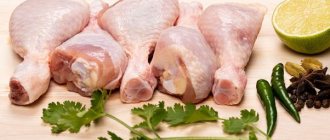Why is nutrition so important for atopic dermatitis?
The main causes of atopic skin rash include poor nutrition.
Some people have intolerance to certain foods and food allergies occur, which triggers an allergic reaction and the appearance of dermatitis. Various studies have found that in most patients diagnosed with atopic dermatitis, diet alleviates the symptoms of the disease and helps control the course of the disease. This occurs due to the fact that foods that can cause an allergic reaction are excluded from the diet. At the same time, the diet itself becomes more moderate, healthy and varied.
Principles of nutrition for atopic dermatitis in adults
If you or a loved one periodically develop atopic dermatitis, then diet is the first thing you should pay attention to. There are several basic rules that should be followed when drawing up a patient’s menu:
Compliance with drinking regime. The patient must drink at least 1.5 liters of water throughout the day; this volume does not include teas, soups and other liquid foods. Thanks to the flow of fluid in the body, metabolic processes are activated, toxins are released from cells and tissues, which sometimes provoke nonspecific allergic reactions. On average, men need to drink about 2.0 - 2.5 liters of water per day, for women this volume is reduced to 1.5 liters (the amount is calculated based on the fact that 30 ml of liquid is needed for every kilogram of body weight).
Fractional meals. The weight of one serving should be about 200 grams, the total number of meals per day should be 5-6 times. Fractional nutrition for atopic dermatitis in adults and children promotes a uniform intake of nutrients and vitamins into the body. This does not create an increased load on the digestive tract and eliminates excess nutrients, which can often provoke allergies.
Mandatory inclusion of protein in the diet. A diet for atopic dermatitis in adults involves a balanced diet, so you should not give up meat and dairy products. The only exception is cow's milk protein intolerance; in this situation, dairy and fermented milk products should be replaced with products of plant origin (soy milk, cheese, etc.). And varieties of meat with a high allergenic potential should be replaced with lean ones.
Inclusion of fats in the diet. A diet for atopic dermatitis in children must certainly contain plant and healthy animal fats. Polyunsaturated fatty acids Omega-3, Omega-6 and Omega-9 are especially valuable for the body. The main sources of these substances are fatty sea fish, but in the case of atopic dermatitis, preference should be given to herring, as well as vegetable oils: sunflower, olive, cottonseed, flaxseed, sesame.
It is advisable to develop a menu for the week for atopic dermatitis in advance. This way you can plan your diet and diversify your diet by including as many different dishes as possible. This is especially important when it comes to children and teenagers, since they don't like to eat the same thing every day.
Diet for dermatitis and psoriasis
A universal form of nutrition for patients with psoriasis involves giving up a number of foods, but at the same time provides a balanced diet that saturates the human body with all the necessary nutrients.
One of these universal nutritional systems was proposed by nutritionist and scientist John Pegano in his book “Treatment of Psoriasis. The natural way." Its basic principle: “The diet for patients with psoriasis should support the correct acid-base balance in the body.” This is necessary in order to help the body cleanse itself and free itself from toxins that have oversaturated it to such an extent that they burst out and appear on the skin in the form of unaesthetic, itchy and flaky psoriatic plaques.
Dr. Pegano believes that “the daily diet of people suffering from psoriasis should consist of 70-80% alkaline-forming foods and 20-30% acid-forming foods. In other words, you need to eat 2-4 times more alkaline-forming foods than acid-forming foods.”
Alkali-forming products (70–80%)
- Juicy fruits and their juices, compotes (especially: grapes, pear, apricot, orange, lemon, grapefruit, lime), baked fruits, fruit puree, fruit jelly
IMPORTANT!
- Strawberries, citrus fruits and their juices should not be eaten if you have psoriatic arthritis or are allergic to them.
- Raw apples, melons and bananas cannot be eaten together with other foods, i.e., for example, as part of fruit salads, cereals, etc. Only as a separate meal.
- Citrus fruits (orange, grapefruit, lemon, lime, tangerine, pomelo) and their juices should not be consumed with whole grain or dairy products, as well as with any products made from white flour, i.e. cereals, bread, pancakes, milk, eggs, butter, yogurt, cheese, etc.
- Juicy vegetables and their juices (especially: celery stalks, spinach, broccoli, carrots, beets, parsley, onions, fresh green salads);
EXCEPT!
- Legumes (dried beans, peas, beans)
- Lentils
- Coarse or dried corn
- Rhubarb
- Large-fruited pumpkins (Hubbard, Acorn, and Butternut varieties)
- Brussels sprouts
They give an acid-forming reaction. You can eat them, but in smaller quantities!
Alkali-forming products (20–30%)
- Lean meat (chicken, turkey, lamb), grilled, steamed, baked
- Fish - large white tuna, cod, mackerel, coryphaena, flounder, grouper, haddock, halibut, grouper, snapper, salmon, sardines, sole, sturgeon, swordfish, trout, tuna, tilefish, whitefish
- Milk – reduced fat or skim, buttermilk, powdered milk powder, goat milk (especially for eczema), soy milk and almond milk (as a dairy substitute)
- Eggs - scalded, soft-boiled or hard-boiled (but not fried), 2-4 per week
- Butter - sweet or unsalted, almond or sesame
- Margarine - low fat and salt, cold pressed: olive, corn, sesame, safflower, sunflower
- Cheese - low in fat and salt, only white (feta, tofu)
- Cottage cheese and processed cheese - simple, low in fat and salt
- Kefir and yogurt - plain, low-fat or low-fat.
- Grains (oats, barley, millet), buckwheat, rye, bran, wheat (whole, cracked, flakes, crispbread, sprouts), corn and cornmeal, rice (brown and wild) and whole seeds (pumpkin, sesame, sunflower , flax).For better absorption of grains, their seeds should be soaked one day before meals (except in the case of diverticulosis in a patient)
- Whole grain bread, pancakes and bagels: made from oats, bran, whole and flaked wheat, rye and wholemeal rye flour, etc.
- Porridges (high in fiber and/or whole grains): made from bran, whole wheat (flakes, sprouts), millet (millet), oats (flakes, crushed grains), boiled and dried wheat groats, etc.
- Instant cereal flakes (muesli) (cooked or cold): wheat, oat, buckwheat, rice or mixed, without preservatives, flavors and other factory additives
- Pasta (if made from whole grains or vegetables without using white flour)
- Pizza (made with whole wheat flour, low-fat cheese, fresh vegetables and a few pieces of turkey or chicken)
- Rice - only brown or wild
- Low-fat unsalted cookies, unsalted wheat or oat bran crackers, unsalted whole grain pretzels, unsalted and unbuttered popcorn
- Honey, maple syrup - as an alternative to sugar
- Oils (olive, also in small quantities peanut, canola, corn, sesame, sunflower, soybean or safflower)
- Ready-made, all-natural seasonings
- Coffee, decaffeinated - no more than 3 cups per day
- Herbal teas (safflower, chamomile, mullein or watermelon seeds)
Exclude
- Nightshades (tomatoes and any products made from them, tobacco, eggplants, potatoes, peppers - except black peppers, paprika)
- Fatty poultry (duck, goose), fried and smoked, baked in batter or breadcrumbs; with a lot of spices; heavily seasoned or served with sauces
- Any red meat, except lamb (beef, pork, veal), as well as everything prepared from it: hamburgers, sausages, sausages, ham, salted beef, sausages, etc.
- Innards (heart, brains, kidneys, liver, etc.);
- You should not include large amounts of starchy foods (bread, peas, corn, rice, pumpkin, etc.) in one meal along with lamb.
- Fish (anchovies, salted or oiled herring, salmon, caviar, baked fish (in batter or breadcrumbs), any salted, dried, fried, smoked or pickled fish)
- Crustaceans and sauces made from them (lobster, shrimp, oysters, crabs, scallops, snails, mussels, squid)
- White milled rice
- White bread and all products made from white flour
- Pizza (white flour, with lots of cheese, tomato sauce, sausage, hot spices)
- Any whole milk products
- Dairy products high in fat, sugar or salt, unnatural
- Light, heavy or whipped cream; ice cream and milkshake
- Artificially colored cheese
- Salted, processed or unnatural butter; hydrogenated margarine
- Fried eggs
- Dairy product with sugar, unnatural syrup or chocolate additives
- Puddings and custards made with whole milk. A mixture of any dairy products with citrus fruits or their juices or with stewed or dried fruits
- Condiments containing wine or grain vinegar, tomato or other nightshades, hot spices
- Products containing large amounts of preservatives, artificial flavors, dyes, etc.
- Sweets that contain sugar or other artificial sweeteners (candy, candy, regular or diet soda, etc.)
- Alcoholic drinks
Of course, if a person suffering from psoriasis also has a food allergy to a specific product, this product must be excluded from the diet in any case.
For a patient with psoriasis, it is very important to take fluids, especially clean water: you need to drink 6-8 glasses of clean water a day in addition to all other drinks!
Water is also effective in curbing appetite. John Pegano: “When you feel hungry and before each meal, it is recommended to drink a glass of water. You can add lemon or lime juice to the water (4–5 fresh fruits per 4 liters of pure spring, filtered, drinking or mineral water). This drink can be cooled, stored in the refrigerator and drunk within 2-3 days. This will help cleanse the body and shift the acid-base balance to the alkaline side.”
“Forbidden” foods for atopic dermatitis
Patients with frequent relapses of skin rashes need to carefully plan their menu and include only healthy foods that do not provoke an exacerbation of dermatitis. Potentially dangerous products that can provoke deterioration of the condition include several groups of products. Thus, a hypoallergenic diet for atopic dermatitis excludes the use of:
- some types of berries and fruits (strawberries, lemon, pomegranate, currants, cranberries);
- certain vegetables and herbs (eggplants, tomatoes, radishes, radishes are prohibited);
- most types of nuts (peanuts, almonds, hazelnuts and others are prohibited).
When creating a menu for atopic dermatitis, patients often strive to eat only natural products. Sugar is also subject to a general ban; instead, natural honey is being added to dishes for sweetness. This is a mistake, since absolutely all bee products are strong allergens. Even a healthy person should use them with caution, in moderation.
Table of allergenicity of products from the Union of Pediatricians
If we talk about the allergenicity of food products, then it largely depends on the body’s susceptibility to food allergens. But there are general recommendations that the Union of Pediatricians recommends following.
Table 2. Permitted and prohibited products
| What you can't eat: | It is possible, but in moderation: | Allowed: |
| Fatty and spicy dishes, spiced cheeses, pickled delicacies. | Whole milk and butter. | Bread made from rye flour. |
| Confectionery and chocolate, as well as desserts with high cocoa content. | Cornflakes. | Cereals: buckwheat, lentils, rice (you will have to soak it first), oatmeal. |
| Mushrooms in any form. | Semolina, white bread. | Lean meat: preference is given to rabbit, lamb, veal, you can include beef tenderloin in the diet. |
| Baked goods made from refined flour, sugar. | Onions and cucumbers. | Olive oil, white cabbage and broccoli. |
| Exotic fruits, fruits and vegetables of red and orange color. | Cranberries, sea buckthorn and other berries are red or yellow. | Zucchini stewed or baked. |
| Honey, nuts, most dried fruits, citrus fruits. Margarine and its contents, mayonnaise and other fatty sauces. | Sawing eggs. | White or green apples. |
| Smoked, canned and salted fish, meat, store-bought convenience foods, carbonated drinks. | Pasta made from durum wheat. | Cottage cheese, kefir, fermented baked milk with low fat content. |
More often, skin rashes appear after eating honey, nuts, red fruits, and citrus fruits. This reaction is also observed when fish dishes are included in the menu. It is rich in mercury, which accumulates under the fins and gills. Therefore, children with atopic dermatitis who are forced to follow a diet do not have fish or seafood in their diet.
“Allowed” products for atopic dermatitis
If you look at the list of foods that are undesirable for patients with atopic dermatitis, it may come as a shock. In fact, not everything is so bad, and there is no need to be upset, since there is always the opportunity to find healthier, but no less enjoyable food alternatives.
The habits of any person can be corrected, and eating habits are no exception. Therefore, it is necessary to endure the first two to three weeks, then the body will adapt to the new diet, and you will begin to feel more alert, energetic, and healthy.
If you look at the list of diets for atopic dermatitis, in most of them patients are allowed to consume:
- lean meats (veal or beef, rabbit, turkey or chicken);
- fish (you should give preference to species with white meat, for example, herring species, the amount of salmon should be limited);
- almost all types of vegetables (especially valuable components of the diet for atopic dermatitis are white cabbage, cucumbers, zucchini and potatoes);
- some fruits and berries (bananas, green apples);
- fermented milk products (we are talking about kefir, cottage cheese and yogurt);
It is recommended to limit the amount of seasonings for atopic rash. You can add a little salt, black or red pepper. Vegetable oil with a small amount of soy sauce is suitable as a salad dressing.
There are also certain recommendations on how to prepare and consume dishes for atopic dermatitis:
- The most suitable way to prepare foods is to boil, bake, steam, grill or stew. In this case, all the beneficial substances in the original ingredients are preserved, and the load on the digestive system is reduced, which cannot be achieved by frying.
- Almost all types of cereals are allowed. Especially often, pearl barley, buckwheat, oatmeal and flaxseed porridge are included in the hypoallergenic diet for atopic dermatitis in children. It is better to cook them with water, since milk can provoke an allergic reaction. To improve the taste of the finished dish, you can add berries and fruits from the list of permitted products. But you should not put nuts, dried fruits or butter.
- Introduce new foods into the diet carefully. To prevent the development of an allergic reaction and prevent the appearance of skin rashes, it is recommended to introduce new foods into the diet carefully, adding them in small quantities. If there is no negative reaction, then you can further increase the amount of consumption (but always remember the principle of moderation and do not overeat).
- Use more vegetables. Vegetables should be used as the basis for the menu in hypoallergenic diets for atopic dermatitis in adults. They can serve as an independent dish, and are well suited as a side dish. They can be added to salads, stews, casseroles, eaten both raw and boiled, stewed. They are versatile, quite nutritious, and contain plenty of vitamins and fiber to support gut health.
General rules
Among inflammatory skin diseases, dermatitis occupies a large share, the most common forms of which are atopic and seborrheic dermatitis . Despite the differences in the etiology and pathogenesis of these forms of dermatitis, the most important element in the treatment of these diseases is a hypoallergenic diet.
Hypoallergenic diet for atopic dermatitis
The main factor in the development of atopic dermatitis (AD) is an inherited predisposition to allergies, which is accompanied by increased production of total immunoglobulin E (IgE), generalized hypersensitivity and a specific reaction of the body to allergens. Hereditary predisposition is realized through a system of various causal factors (triggers) and environmental factors. Atopic dermatitis in the vast majority of cases is caused by food allergens. The most important causal allergens in adults are cow's milk proteins, chicken eggs, fish and seafood, cereals, soy proteins, red-orange vegetables and fruits, and nuts. It is against the background of food allergy, which is a factor of initial sensitization, that the body’s hypersensitivity to other allergens is formed through the mechanism of cross-reactions.
For children, the high antigenic load on the fetus is of great importance during the pathological course of pregnancy , with improper nutrition of the mother during lactation, early introduction of complementary foods or transfer to artificial feeding with the introduction of foods in the diet that are not appropriate for the child’s age, as well as pathology of the gastrointestinal tract and dysbiosis intestines, which causes increased absorption of various antigens .
The diet of a patient with atopic dermatitis is based on the principle of elimination - excluding foods and dishes from the diet:
- containing causally significant and cross allergens;
- having high sensitizing activity;
- including artificial food additives ( antioxidants , dyes, preservatives, flavors);
- promoting the release of histamine (chocolate, coffee, orange juice, cow's milk, wheat bran);
- containing a large amount of biogenic amines (histamine carriers) - tomatoes, strawberries, cocoa, legumes, hazelnuts, tuna, cheeses, smoked meats, spinach, herring fillets.
An elimination diet is selected for each patient individually, taking into account his “personal” food allergens and the list of “potentially allergenic foods,” as well as the stage of the disease.
In the acute period, the basis of the diet consists of foods with weak allergenic activity: lean beef, boiled chicken, pumpkin (light colors), squash, zucchini, offal (liver, kidneys, tongue), turnips, garden greens, green apples, cucumber , fermented milk products, low-fat cottage cheese, oatmeal, rice and pearl barley, plums, gooseberries, white currants, watermelon, olive and sunflower oil, pears, dried fruits, butter. At the same time, individual food allergens (if known) are excluded.
When preparing dishes during this period, you must follow a number of rules:
- the allergic activity of products is significantly reduced by heat treatment, so it is necessary to minimize the consumption of raw vegetables and fruits;
- Before eating, potatoes should be kept in cold water for several hours to reduce the starch content;
- porridge must be cooked in the third water - after boiling, the water must be drained and new water must be poured in, repeat twice;
- When preparing broths, vegetable purees and soups, the first water after boiling should also be drained.
If the allergen product is not known, then to identify it, a rotation diet , the essence of which is to divide the food products into several groups (meat, vegetables, dairy, cereals, fruits). The basic principle of this diet is to include in the daily diet for four days only one product from each group (1 type of meat, 1 type of cereal, 1 type of vegetable/fruit, 1 type of lactic acid products, 1 type of cereal). Repetition of any product is allowed only from the 5th day. This way you monitor reactions to products. If any product in the food set arouses your suspicions, try introducing it into the diet again in another set. If the reaction occurs again, it must be excluded from your diet. For analysis, it is recommended to keep a food diary.
The duration of a strict diet for an adult patient should be about 3 weeks and for children - 10 days. The fact of persistent disappearance of the symptoms of the disease can serve as a guide. Next, the diet is expanded to include foods with average allergenic activity.
First, white bread, boiled pork and lean white fish, fresh onions, green/yellow vegetables and fruits are introduced, and if there is no negative reaction, orange and red fruits/vegetables are introduced, as well as freshly squeezed juices, compotes and fruit purees. Thus, the basic diet of a patient with atopic dermatitis is formed. Products with a high allergic potential (eggs, milk, seafood, fish, citrus fruits, melon, chocolate, fish caviar, tomatoes, honey, nuts, strawberries), but important in terms of micronutrient content and energy significance, can be tried to be introduced gradually, one at a time and starting with small quantities. And, based on the body’s reaction to them, decide the possibility of including them in the basic diet. The following table gives some idea of the allergenic potential of products.
| Allergenic potential of products | Products |
| High degree of allergenic activity | Cow's milk, chicken egg, crustaceans, chocolate, cheese, fish, coffee, nuts, mustard, wheat, strawberries, strawberries, raspberries, beets, grapes, persimmons, melon, cocoa, red caviar, tomatoes, pomegranates, celery, black currants, carrots, pineapples, blackberries, spices, sauces, citrus fruits, honey, mushrooms, canned and pickled foods, smoked meats, carbonated and alcohol-containing drinks. |
| Average degree of allergenic activity | Turkey, pork, rabbit, potatoes, rice, peas, apricots, peaches, cranberries, corn, green peppers, buckwheat, bananas. |
| Weak degree of allergenic activity | Beef (low-fat varieties), lamb, boiled chicken, pumpkin (light colors), turnips, zucchini, squash, fermented milk products, green and yellow apples, gooseberries, plums, white currants, garden herbs, butter, green cucumber, watermelon , offal (liver, tongue, kidneys), almonds, pearl barley, rice, oatmeal, olive pears, and sunflower oil, dried fruits. |
The diet of a patient with atopic dermatitis should limit foods containing easily digestible carbohydrates: confectionery, honey, sugar, jam, sweets. It is recommended to replace sugar completely with xylitol , saccharin , and aspartame . The diet should include foods rich in calcium (fermented milk products, cottage cheese), which have a pronounced antiallergic effect, and limit foods rich in oxalic acid , which interferes with the absorption of calcium. Strong broths, spicy and smoked dishes, sauces and seasonings are excluded. Salt and any salty foods are subject to restrictions.
In case of allergic dermatitis , the trigger for the development of which is not food factors, but direct contact with the allergen (through skin contact with it), it is extremely important to first eliminate the causative factor and the time of its exposure. Contact sensitization of the body occurs in both adults and children, even in the first months of life. The cause is most often chemical ingredients and dyes in plastic products, toys, which cause rashes and redness on the hands and face, and the composition of clothing.
The difficulty in identifying a contact allergen factor lies in the fact that it is very difficult to trace the connection with the triggering action of any chemical reagent, since the aftereffect is often delayed. That is, contact with the allergen has already been eliminated, and clinical manifestations of dermatitis develop after 24-48 hours.
In any case, for atypical allergic contact dermatitis, a general hypoallergenic diet is indicated. The same anti-allergenic nutrition is required for oral dermatitis and treatment of Dühring's dermatitis . However, dietary nutrition for Dühring's dermatitis additionally provides for the complete exclusion from the diet of foods containing gluten (gluten), which is a complex protein found in cereals (wheat, rye, barley). The diet for oral dermatitis, in addition to the general requirements for a hypoallergenic diet, includes the exclusion of hot, hot, spicy foods and foods containing coarse dietary fiber to reduce irritation of the affected part of the skin around the oral cavity.
Seborrheic dermatitis is caused by an increase in the secretion and change in the composition of sebum, accompanied by hyperactivation of the fungal microflora of the genus Malassezia and inflammation of the skin. With seborrheic dermatitis, areas of shiny, greasy, thickened skin and dandruff on the head with areas of erythema on the skin, which are accompanied by mild itching, appear on the face, head, and back. Nutrition for seborrhea should be physiologically complete with a menu limit of white bread, animal fats, refined carbohydrates, salt, hot seasonings and spices, and foods containing a lot of cholesterol . The basis of the diet should be dairy products, low-fat fish, boiled meat, brown bread and foods rich in fiber (porridge, vegetables/fruits).
Atopic dermatitis in childhood: nutritional features
Since in most cases atopic skin rash occurs in newborns and children under two years of age, it is necessary to dwell separately on nutrition issues at this age.
As a rule, infants are highly dependent on how their mother eats. Therefore, if a skin reaction occurs in a child, a woman should pay attention to her diet and adjust it. If this is not possible, then you should choose a safe infant formula. It is best to opt for formulations based on hydrolyzed protein.
In case of chronic atopic dermatitis in children, complementary foods must be introduced very carefully:
- the optimal age for the first complementary feeding is 4-6 months;
- New foods should be added to the diet only during the period of remission of the disease, when the skin reaction can be monitored;
- the first complementary food should be monocomponent (that is, consist of one type of product);
- each new product is introduced into the child’s diet gradually, 1-2 weeks are given to adapt to it, other new products are not introduced into the child’s diet during this period;
- a new product is included in the child’s diet for the first time in an amount of no more than 5 ml (g), preferably in the morning feedings, in order to be able to assess its tolerability during the day (the appearance or intensification of skin rashes, changes in stool);
- in the absence of an allergic reaction, the volume of the new product is increased daily by 10 - 30 g until the age-appropriate volume of the dish is reached within 5 - 7 days;
- More often, the first complementary food is a monocomponent puree of light-colored vegetables: zucchini, squash, cauliflower, cabbage, Brussels sprouts, broccoli
- with low body weight, the first complementary food can be dairy-free, gluten-free porridge (buckwheat, corn, rice), then vegetables are introduced;
- the first fruit complementary food is pureed apples or light-colored pears;
- the use of complementary foods containing milk, sugar, preservatives, food colors and flavors, salt, and gluten is excluded.
The menu for children over the age of one year becomes more complicated. But even here, the use of highly allergenic foods should be avoided, culinary processing should be gentle, dyes and preservatives should be avoided, and it is important to monitor the child’s reaction to a new product.
The diet for atopic dermatitis in adolescents is no different from the principles of nutrition for adults. But difficulties can arise here, since teenagers tend to communicate with their peers and follow their example. It is important not just to forbid a child to eat what he wants, you need to explain with reason why he should not eat this or that product. When a teenager consciously refuses sweets, fast food, and soda, which can cause an exacerbation of atopic dermatitis, it is easier for him to control his diet and prevent breakdowns. This is an extremely important point that influences the psychosomatic manifestation of the disease.
Principles of introducing complementary foods for atopic dermatitis
About 10% of allergic diseases are atopic dermatitis (AD), which is especially common in infants and young children [1].
According to modern concepts, AD is a chronic itchy skin disease with a relapsing course, which is part of the atopic syndrome [2]. There is a certain pattern in the development of symptoms of atopic syndrome, designated by the concept of “atopic march” [3, 4]. The atopic march includes AD, food allergies, atopic bronchial asthma, allergic rhinitis and eosinophilic esophagitis [5] (Fig. 1).
Atopic dermatitis in the vast majority of cases is the initial disease, which subsequently leads to damage to the respiratory and digestive systems. This phenomenon is based on epicutaneous sensitization, which occurs due to concomitant disruption of the barrier structures of the skin in children with AD [6, 7]. There are a lot of factors that provoke AD (Fig. 2).
In infants and young children, the most common provoking factor is food allergens; therefore, a properly structured diet will delay the manifestation of the disease, quickly achieve and long-term maintain remission of dermatosis, and is also a promising way to stop or prevent the development of atopic march [8, 9].
Of course, the optimal nutrition for a baby is mother's milk, the role of which can hardly be overestimated. It forms a special psychological relationship between mother and child, and also has a wide range of unique properties, including the formation of immunological tolerance to food antigens. Breast milk helps reduce the antigenic and infectious load on the child’s body, and is also one of the first and main factors ensuring the formation of the child’s microbiome [10, 11].
Despite the obvious advantages of breast milk, by the end of the first six months it ceases to fully satisfy the growing needs of the child’s body for nutrients and energy. It was established that the child was 6 months old. receives less than 50% of the required amount of microelements and essential vitamins from breast milk [12, 13].
According to the “National Program for Optimizing the Feeding of Children in the First Year of Life in the Russian Federation,” complementary feeding means all products, except human milk and infant formula, that supplement the diet with nutrients necessary for the further growth and development of the child. Prescribing complementary foods allows you to optimize the diet in terms of nutrient content, stimulate the development of the digestive system, its motor skills and chewing apparatus, expand the range of taste sensations and shape eating behavior [14]. The main factors determining the advisability of introducing complementary foods are the biological maturity of the child and his readiness to accept new food (Fig. 3).
Traditionally, when introducing complementary foods, it is recommended to adhere to the following rules:
a new product/dish should be introduced to a healthy child;
introduce a new product/dish outside of preventive vaccinations, teething, climatic disasters (heat);
Always give a new product/dish before breast milk/formula;
introduce a new product/dish with a small dose, gradually increasing it to the required volume.
The introduction of complementary feeding in children with AD has its own characteristics. Numerous studies have shown that in children with a burdened medical history or an existing disease, the introduction of complementary foods can serve as a trigger factor leading to the manifestation or exacerbation of a skin process [16, 17]. However, prescribing an elimination diet in patients with AD, especially in infants and young children, is justified only if the presence of food sensitization is proven. There is no general “atopic dermatitis diet.”
Based on this, we can formulate the basic principles of introducing complementary feeding in children with AD:
timeliness;
hypoallergenic;
individuality;
gradualism;
monocomponent.
Russian nutritionists, as well as ESPGHAN experts, recommend that all children introduce complementary foods between 4 and 6 months. [18, 19]. It has been proven that both early and delayed introduction of complementary foods have equally adverse effects on the health and development of the child. With the early introduction of complementary foods, the formation of food tolerance is disrupted and there is a discrepancy between the food offered and the enzymatic capabilities of the child, which is manifested by gastrointestinal dysfunction. In addition, with the early introduction of complementary foods, the child is more exposed to the risk of exposure to pathogenic microorganisms that can get into food. Late introduction of complementary foods leads to the development of protein and micronutrient deficiencies and a decrease in growth and maturation. There may be a delay in acquiring the ability to eat solid foods and insufficient stimulation of the taste and olfactory receptors. Such children subsequently gravitate toward liquid and pureed foods and exhibit various variants of selective appetite.
For children with AD, the recommended timing of introducing complementary foods is practically no different from those for healthy children. If the mother has sufficient lactation, complementary feeding products and dishes begin to be introduced to children with AD during the period of remission of the disease at the age of 4–6 months. taking into account the spectrum of individual sensitization [20]. According to the American Academy of Pediatrics, infants who are exclusively breastfed for at least 3–4 months have a significantly lower incidence of early AD development than infants who receive breast milk for a short period of time or who do not receive it at all [21, 22].
An important condition for introducing complementary foods to children with AD is taking into account the degree of allergenic potential of the product. Almost all food products have some degree of antigenicity. In infants and young children, the most significant food allergens are cow's milk proteins, egg proteins, gluten, and banana (Table 1).
When choosing the first type of complementary food, in addition to the spectrum of food allergens, it is necessary to take into account the nutritional status of the child and the state of his digestive system. Thus, it is considered advisable for children with insufficient weight gain, sideropenia, and a tendency to diarrhea to use cereal complementary foods first; for constipation and paratrophy, use vegetable complementary foods. However, this is advisory rather than mandatory, and in practice the issue is resolved individually. For children with AD, gluten-free cereals are used - buckwheat, corn, rice, quinoa, which can be diluted with breast milk, formula or water. To prepare vegetable puree, take light-colored vegetables - various types of cabbage (cauliflower, cabbage or Brussels sprouts), zucchini and squash. When choosing complementary meat, in addition to allergenicity (rabbit, turkey, horse meat, pork, nutria), the religious restrictions of the family are taken into account. It is recommended to use seasonal fruits from the area where the child was born. In the presence of identified and proven sensitization to cow's milk proteins and eggs, fermented milk complementary foods, butter and egg yolk are introduced into the diet at the age of no earlier than 12 months. and only after established tolerance to the product (Table 2).
Also, when introducing complementary foods to children with AD, it is necessary to take into account the spectrum of individual sensitization to create a personalized elimination diet. To more successfully identify the presence of sensitization to certain foods, it is recommended to keep a food diary throughout the entire period of introducing complementary foods, recording all negative reactions to food in it. Adaptation and individual tolerance of the new product are assessed by changes in the skin and visible mucous membranes, stool and the child’s well-being. If there is a deterioration in the condition, a rash appears, the child becomes restless, changes in the gastrointestinal tract occur and these disturbances are moderate in nature, you can not cancel the administered product for 2-3 days or increase its volume. If after the specified time all symptoms disappear, this can be regarded as a process of adaptation to the new food, and the introduction of the product can be continued, but if the symptoms increase, the product must be discontinued. In addition, it is important to remember about possible cross-reactions to biologically related foods (Table 3).
The duration of elimination of causally significant products is at least 6 months; in case of severe reactions, the diet is extended to 12–18 months. [25]. After the onset of remission of the skin process, it is possible to conduct a diagnostic administration of the previously excluded product, starting with a dose that is half that which caused the negative reaction [26].
The principle of gradualism is that each new product is introduced one by one and slowly, with 7–14 days allotted for complete adaptation to it. You should start with 5 ml, gradually increasing the volume of the dish to the required amount. It is recommended to introduce all new products in the first half of the day to be able to monitor the child. In addition, it is known that the level of histamine and other biologically active substances increases in the afternoon, therefore, a more pronounced allergic reaction can be expected [27].
The introduction of any new type of food should begin with monocomponent dishes, as this allows you to understand which foods are not suitable for the child. Preference should be given to industrially produced complementary feeding products and dishes, which have a number of advantages compared to home-cooked dishes:
made from proven high-quality raw materials;
free from toxic impurities and pathogenic microorganisms;
have a guaranteed chemical composition in accordance with the age-related needs of children of different ages;
the degree of grinding corresponds to the age characteristics of the masticatory apparatus and digestive system.
The choice of industrially produced complementary feeding products and dishes is currently extremely wide, which allows you to completely create a diet for a child with any needs. All of the above criteria are met by products that have a wide selection of hypoallergenic monocomponent complementary foods, such as vegetable purees from zucchini, broccoli, cauliflower, pumpkin; fruit purees from apples, pears, prunes; dairy-free enriched porridges from buckwheat, rice, corn; meat purees from turkey, rabbit; juices from apples, pears, from apples and pears. The low sensitizing potential of these products has been clinically proven, which makes it possible to recommend them to children both at high risk for the development of atopy and those already having clinical manifestations of AD [28].
In conclusion, it must be noted once again that there is no single hypoallergenic diet that would suit everyone and be equally effective. However, the use of the results of scientific research conducted in accordance with the principles of evidence-based medicine will optimize the introduction of complementary foods to children at risk or with chronic allergic diseases, including AD. An individual approach and a gradual increase in the load on the child’s body will help stop or prevent the development of atopic march.
Gratitude
The editors thank you for your assistance in technical editing of this publication.
Acknowledgment
Editorial Board is grateful to JSC “PROGRESS” for the assistance in technical edition of this publication.
Information about authors:
Botkina Alexandra Sergeevna - Candidate of Medical Sciences, Associate Professor of the Department of Hospital Pediatrics named after. Academician V.A. Tabolin pediatric faculty of Federal State Autonomous Educational Institution of Higher Education Russian National Research Medical University named after. N.I. Pirogov of the Russian Ministry of Health; 117997, Russia, Moscow, st. Ostrovityanova, 1; ORCID iD 0000-0001-6890-2041.
Dubrovskaya Maria Igorevna - Doctor of Medical Sciences, Professor of the Department of Hospital Pediatrics named after. Academician V.A. Tabolin pediatric faculty of Federal State Autonomous Educational Institution of Higher Education Russian National Research Medical University named after. N.I. Pirogov of the Russian Ministry of Health; 117997, Russia, Moscow, st. Ostrovityanova, 1; ORCID iD 0000-0002-3487-2451.
Contact information: Botkina Alexandra Sergeevna, e-mail: [email protected]
Financial transparency: none of the authors has a financial interest in the materials or methods presented.
There is no conflict of interest.
The article was received on July 19, 2021.
Received after review on 08/05/2021.
Accepted for publication on August 27, 2021.
About the authors:
Mariya I. Dubrovskaya – D. Sc. (Med.), professor of Acad. VA Tabolin Department of Hospital Pediatrics of the Pediatric Faculty, Pirogov Russian National Research Medical University; 1, Ostrovityanov str., Moscow, 117437, Russian Federation; ORCID iD 0000-0002-3487-2451.
Aleksandra S. Botkina - C. Sc. (Med.), associate professor of Acad. VA Tabolin Department of Hospital Pediatrics of the Pediatric Faculty, Pirogov Russian National Research Medical University; 1, Ostrovityanov str., Moscow, 117437, Russian Federation; ORCID iD 0000-0001-6890-2041.
Contact information: Alexandra S. Botkina, e-mail
Financial Disclosure: no authors have a financial or property interest in any material or method mentioned.
There is no conflict of interests.
Received 07/19/2021.
Revised 08/05/2021.
Accepted 08/27/2021.
How to maintain a balance of proteins, fats and carbohydrates?
The diet for chronic atopic dermatitis is selected in such a way that the patient’s menu maintains a balance between the consumption of proteins, fats and carbohydrates. When the volume of one of these elements decreases, the body experiences a deficiency, which affects the functioning of all internal organs and systems. Such an “imbalance” can lead to exacerbation of chronic diseases, including the appearance of skin rashes.
To ensure the supply of necessary substances, the menu should include:
- Proteins in an amount of at least 30% of the total volume of incoming food. Protein (or protein) is the main building block for body tissues. For atopic dermatitis, it is especially necessary because it helps restore damaged skin. The main sources of protein are veal, rabbit and turkey meat, fish, and dairy products.
- Carbohydrates in an amount of at least 50% of the volume of daily food consumed. Carbohydrates become the main source of energy; they help keep the body in good shape. Also, many fruits and vegetables rich in carbohydrates contain essential fiber, which ensures the normal functioning of the gastrointestinal tract. You can get a large amount of carbohydrates from vegetables, fruits and cereals.
- Fats in an amount of at least 20% of the total food eaten per day. Thanks to fats, many vital processes in the body are supported; they are important elements in the production of hormones and the construction of cell membranes. Fats keep the skin healthy, it becomes firm and elastic, and its natural protective barrier is maintained. Depending on individual health conditions, doctors often insist on increasing fat intake by reducing the amount of carbohydrates. This is a perfectly acceptable compromise.
If, due to food intolerance, the patient is unable to achieve sufficient protein intake, then in this case it is recommended to include special hypoallergenic protein supplements in the nutrition plan.
Recipes for simple and affordable dishes for atopic dermatitis
The advantages of the diet recommended for patients with dermatitis boil down to the fact that their menu is quite simple, all dishes are easy and quick to prepare. In addition, by reducing their calorie content, weight loss can be achieved.
We recommend you several very satisfying, but at the same time healthy dishes.
- Stew with turkey and zucchini. To prepare, you will need 500 grams of zucchini (you can use squash, cauliflower or broccoli), 500 grams of turkey fillet and one leek. Cut all ingredients into large cubes, place in a saucepan, add a small amount of water and simmer over low heat. 10 minutes before readiness, pour in a tablespoon of vegetable oil, lightly add salt and add a tablespoon of sour cream. This is a hearty dish in itself, and also a good addition to any side dishes of buckwheat, potatoes, or rice.
- Veal with apples. The dish is prepared very simply from a minimum set of ingredients. You will need 500 grams of veal fillet, 2-3 green apples and a leek. Cut all the ingredients into small pieces (veal into cubes, apples into slices, leeks into rings), place in a fireproof bowl, lightly add salt and pepper, pour in a couple of tablespoons of vegetable oil and 100 ml of water. Bake in the oven at 180 degrees until done.
- Fruit and berry smoothie. When, due to dietary restrictions, you don’t have enough sweets, a smoothie will help out in this situation. It is prepared from a glass of kefir with the addition of any permitted berries and fruits (for example, banana or white currants). Just grind all the ingredients in a blender and your delicious smoothie is ready.
As you can see, a well-chosen diet for atopic dermatitis helps to increase the effectiveness of treatment, helps keep the disease under control and reduce the severity of its symptoms. At the same time, the menu remains varied and tasty.
Fully or partially limited products
A hypoallergenic diet involves the exclusion of meat and fish broths and dishes prepared using them. It is prohibited to consume any fatty varieties of red meat, chicken eggs, smoked meats, most sausages, duck, seafood (mussels, shrimp, squid), honey and honey products, all salty foods, canned food, pickled vegetables, cream, cooking and animal fats, sour cream , sweet curds, salty and fatty cheeses.
Excluded: sugar, ice cream, confectionery, jam, honey, sweets, jams. Semolina, white rice, pasta, and soy are also subject to restrictions. The menu of a hypoallergenic diet should not include products containing any food additives, fruit tea, fruit/vegetable juices from prohibited berries, sweet carbonated drinks and all drinks containing carbon dioxide and alcohol.
All seasonings (mayonnaise, ketchup, mustard, horseradish), vinegar, eggplant, mushrooms, pineapple, melon, butter dough, as well as all fruits/vegetables of red and orange color (carrots, tangerines, beets, tomatoes, red apples) are also excluded from the diet , strawberries, oranges, radishes, radishes, strawberries), nuts, coffee.
Table of prohibited products
| Proteins, g | Fats, g | Carbohydrates, g | Calories, kcal | |
Vegetables and greens | ||||
| carrot | 1,3 | 0,1 | 6,9 | 32 |
| salad pepper | 1,3 | 0,0 | 5,3 | 27 |
| tomatoes | 0,6 | 0,2 | 4,2 | 20 |
Fruits | ||||
| oranges | 0,9 | 0,2 | 8,1 | 36 |
| bananas | 1,5 | 0,2 | 21,8 | 95 |
| pomegranate | 0,9 | 0,0 | 13,9 | 52 |
| grapefruit | 0,7 | 0,2 | 6,5 | 29 |
| lemons | 0,9 | 0,1 | 3,0 | 16 |
| mango | 0,5 | 0,3 | 11,5 | 67 |
| tangerines | 0,8 | 0,2 | 7,5 | 33 |
Berries | ||||
| grape | 0,6 | 0,2 | 16,8 | 65 |
| Red currants | 0,6 | 0,2 | 7,7 | 43 |
Nuts and dried fruits | ||||
| nuts | 15,0 | 40,0 | 20,0 | 500 |
| raisin | 2,9 | 0,6 | 66,0 | 264 |
Cereals and porridges | ||||
| white rice | 6,7 | 0,7 | 78,9 | 344 |
Confectionery | ||||
| jam | 0,3 | 0,2 | 63,0 | 263 |
| jam | 0,3 | 0,1 | 56,0 | 238 |
| candies | 4,3 | 19,8 | 67,5 | 453 |
| pastry cream | 0,2 | 26,0 | 16,5 | 300 |
Ice cream | ||||
| ice cream | 3,7 | 6,9 | 22,1 | 189 |
Cakes | ||||
| cake | 4,4 | 23,4 | 45,2 | 407 |
Chocolate | ||||
| chocolate | 5,4 | 35,3 | 56,5 | 544 |
Raw materials and seasonings | ||||
| mustard | 5,7 | 6,4 | 22,0 | 162 |
| ketchup | 1,8 | 1,0 | 22,2 | 93 |
| mayonnaise | 2,4 | 67,0 | 3,9 | 627 |
| honey | 0,8 | 0,0 | 81,5 | 329 |
| vinegar | 0,0 | 0,0 | 5,0 | 20 |
Dairy | ||||
| condensed milk | 7,2 | 8,5 | 56,0 | 320 |
| cream | 2,8 | 20,0 | 3,7 | 205 |
| sour cream 30% | 2,4 | 30,0 | 3,1 | 294 |
| sour cream 40% (fat) | 2,4 | 40,0 | 2,6 | 381 |
Cheeses and cottage cheese | ||||
| cheese | 24,1 | 29,5 | 0,3 | 363 |
| dor blue cheese | 21,0 | 30,0 | 0,0 | 354 |
| blue cheese | 17,6 | 31,0 | 1,8 | 363 |
| amber processed cheese | 7,0 | 27,3 | 4,0 | 289 |
| cottage cheese 18% (fat) | 14,0 | 18,0 | 2,8 | 232 |
Meat products | ||||
| fatty pork | 11,4 | 49,3 | 0,0 | 489 |
| pork fat | 1,4 | 92,8 | 0,0 | 841 |
| salo | 2,4 | 89,0 | 0,0 | 797 |
| mutton | 15,6 | 16,3 | 0,0 | 209 |
Sausages | ||||
| smoked sausage | 16,2 | 44,6 | 0,0 | 466 |
| smoked sausage | 9,9 | 63,2 | 0,3 | 608 |
| sausages | 10,1 | 31,6 | 1,9 | 332 |
| sausages | 12,3 | 25,3 | 0,0 | 277 |
Bird | ||||
| smoked chicken | 27,5 | 8,2 | 0,0 | 184 |
| duck | 16,5 | 61,2 | 0,0 | 346 |
| smoked duck | 19,0 | 28,4 | 0,0 | 337 |
| goose | 16,1 | 33,3 | 0,0 | 364 |
Eggs | ||||
| chicken eggs | 12,7 | 10,9 | 0,7 | 157 |
Fish and seafood | ||||
| smoked fish | 26,8 | 9,9 | 0,0 | 196 |
| salted fish | 19,2 | 2,0 | 0,0 | 190 |
| Red caviar | 32,0 | 15,0 | 0,0 | 263 |
| black caviar | 28,0 | 9,7 | 0,0 | 203 |
| canned fish | 17,5 | 2,0 | 0,0 | 88 |
| semi-finished fish products | 12,5 | 6,7 | 14,7 | 209 |
| sardine | 20,6 | 9,6 | — | 169 |
| mackerel | 18,0 | 13,2 | 0,0 | 191 |
Oils and fats | ||||
| creamy margarine | 0,5 | 82,0 | 0,0 | 745 |
| coconut oil | 0,0 | 99,9 | 0,0 | 899 |
| palm oil | 0,0 | 99,9 | 0,0 | 899 |
| rendered beef fat | 0,0 | 99,7 | 0,0 | 897 |
| cooking fat | 0,0 | 99,7 | 0,0 | 897 |
| rendered pork fat | 0,0 | 99,6 | 0,0 | 896 |
Alcoholic drinks | ||||
| white dessert wine 16% | 0,5 | 0,0 | 16,0 | 153 |
| dry white wine | 0,1 | 0,0 | 0,6 | 66 |
| vodka | 0,0 | 0,0 | 0,1 | 235 |
| cognac | 0,0 | 0,0 | 0,1 | 239 |
| liquor | 0,3 | 1,1 | 17,2 | 242 |
| beer | 0,3 | 0,0 | 4,6 | 42 |
Non-alcoholic drinks | ||||
| cola | 0,0 | 0,0 | 10,4 | 42 |
| black coffee | 0,2 | 0,0 | 0,3 | 2 |
| Pepsi | 0,0 | 0,0 | 8,7 | 38 |
| sprite | 0,1 | 0,0 | 7,0 | 29 |
| tonic | 0,0 | 0,0 | 8,3 | 34 |
| energy drink | 0,0 | 0,0 | 11,3 | 45 |
Juices and compotes | ||||
| cranberry jelly | 0,0 | 0,0 | 13,0 | 53 |
| * data is per 100 g of product | ||||
Highly allergenic foods
The products that most often cause allergies include:
- Chicken eggs, chicken meat, cow's milk, mushrooms, citrus fruits (oranges, tangerines, grapefruits), pineapples, persimmons, melons, strawberries, raspberries, wild strawberries, black catfish, honey, chocolate and candies, nuts (especially peanuts), fish, seafood products , fish caviar, smoked products, sausages, canned products, dried fruits, sweet carbonated drinks, coffee, cocoa, products with a large number of chemical additives (preservatives, dyes, flavors, stabilizers), wheat, rye
When creating a hypoallergenic and elimination diet for atopic dermatitis in adults and children, they should be avoided without fail, especially in the case of nursing mothers.
Hypoallergenic diet for pregnant and nursing mothers with atopic dermatitis
During breastfeeding, a number of dietary restrictions must be observed. In this case, the risk of the child developing atopic dermatitis is much lower. If the parents have been diagnosed with allergic reactions, bronchial asthma or atopic rhinitis, following a diet for dermatitis in adults (preferably at the stage of preparation for conception) is simply necessary.
A pregnant or breastfeeding woman should avoid the same foods that are prohibited for all adults suffering from an atypical reaction (see above).
Products of average allergic risk
Less likely to cause allergies are foods such as:
- Quail eggs, apricots, peaches, pomegranates, various berries (including red currants and cranberries), tomatoes, carrots, beets, legumes, including soybeans, seasonings, corn, buckwheat, potatoes, peas, pork, turkey, red apples, broccoli, oats , barley
When creating a menu for atopic dermatitis, they can be included in the diet in small quantities, carefully monitoring the condition of the skin after each meal. In case of deterioration, it is necessary to note in the food diary which foods caused the reaction in order to exclude them in the future.
For children
Treatment of children with atopic dermatitis involves the elimination of causally significant food/non-food allergens, the role of which in exacerbating the disease has already been proven. The basis for exclusion from a child’s diet is the establishment of a connection between the disease and exposure to a causally significant allergen and sensitization to it identified according to the results of an allergological examination (positive skin testing or detection of specific immunoglobulins E ).
When in doubt, as well as in the presence of multiple food sensitization, provocative tests are performed with food products - suspected allergens - to confirm hypersensitivity. It is important to achieve complete exclusion of the allergen from the diet, taking into account its possible hidden presence in other foods and taking into account potential cross-reactivity.
The duration of the elimination diet should be 6–12 months and is determined individually. After this period, a repeat allergological examination is carried out, which determines the possibility of using an allergen product in the child’s diet. However, at the same time, the diet must correspond to the age-related nutritional needs of children and be balanced in proteins, fats and carbohydrates .
When transferring a child under one year of age to artificial/mixed feeding, one should not include in the diet mixtures based on whole cow's milk, as well as milk from other animals (goat, sheep) and mixtures based on partial hydrolysis of cow's milk protein and soy protein. It is better to use mixtures based on a high degree of whey protein hydrolysis: Frisopep , Alfare , Nutrilon Pepti TSC , or casein hydrolysis: Frisopen AS , Pregestimil , Nutramigen .
If the effectiveness of diet therapy based on mixtures of highly hydrolyzed protein (after 2-4 weeks of use) and in severe forms of the disease is low, it is recommended to use mixtures based on amino acids ( Neokey ). A hypoallergenic diet for older children is based on similar principles, but you should not overuse the child on it for a long time, as this can cause a disruption in his physical development. A strictly restrictive diet is recommended to be used only during the period of exacerbation of atopic dermatitis, no more than 7-10 days, and after identifying and eliminating causative allergenic foods from the diet, it is necessary to transfer the child to an individual hypoallergenic diet.
Alkali-forming products (70–80%)
Alkali-forming products are products that help maintain the pH of the internal environment of the body at a slightly alkaline level, close to neutral, preventing a shift in acidity towards an acidic environment. It is the acidification of tissues that supports the chronic inflammatory process in the body, including on the skin, according to some scientists, therefore the inclusion of alkali-forming foods in the diet is necessary for atopic dermatitis. The most powerful alkaline foods include:
- Lemons, celery, lettuce, greens, cucumbers, radishes, beets, carrots, avocado, cabbage
Opposite foods, that is, those that cause acidification of tissues and can support chronic inflammation, include meat, especially fatty meats, fermented milk products based on cow's milk, cheeses, baked goods, sweets, chocolate, coffee, black tea, alcoholic products .
Reviews and results
According to patient reviews, eliminating causally significant food allergens from the diet can reduce the clinical manifestations of atopic dermatitis , and in chronic cases, lengthen periods of remission.
- “... Allergic diathesis in my daughter first appeared at the age of 6 months after the introduction of complementary foods based on cow's milk. I had to switch the child to special artificial formulas. However, diathesis appeared periodically for up to 2 years. Obviously, the child reacted to some other product, but we could not establish it for sure. After two years of diathesis, the rashes stopped on their own, but we, on the advice of the doctor, still adhere to a hypoallergenic diet”;
- “... My baby developed allergic dermatitis when complementary foods were introduced. We found out that this is a reaction to juices. The juices were stopped, and the condition immediately improved. At 6 months of age, I again tried to introduce various juices into the diet one by one and again had a negative reaction to almost all of them. It is a pity that the child is deprived of the opportunity to receive them. The doctor said that perhaps later the diathesis on juices will go away. We really hope so. I myself follow a hypoallergenic diet, and if I have a breakdown during the holidays, I drink sorbent and take a light antihistamine.”
Alkali-forming products (20–30%)
In general, it is worth saying that almost all fruits, vegetables, herbs, spices, alkaline herbal tea, vegetable juices, whole milk, whey, oatmeal, fresh beans, potatoes with skin, any berries, dates, dried figs, almonds, raisins , prunes, and natural juices are classified as alkali-forming products.
Compliance with these simple recommendations, together with the use of effective topical therapy for atopic dermatitis, will reduce the frequency and severity of exacerbations and improve the general condition of patients.










